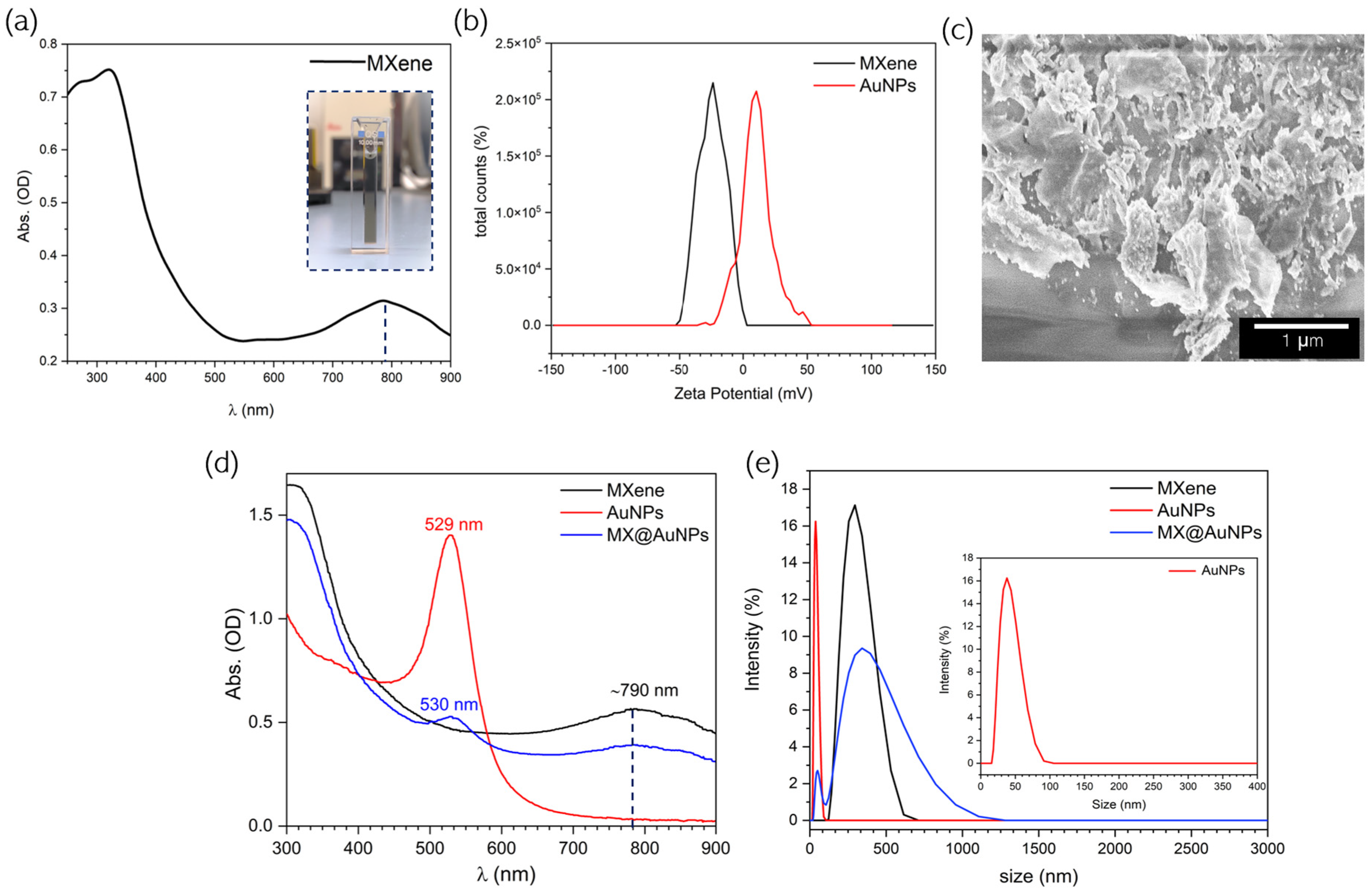One-Step Synthesis of Robust 2D Ti3C2-MXene/AuNPs Nanocomposite by Electrostatic Self-Assembly for (Bio)Sensing †
Abstract
:1. Introduction
2. Materials and Methods
2.1. Materials
2.2. Synthesis of MXene
2.3. Synthesis of Positively Charged Gold Nanoparticles
2.4. Synthesis of MXene and Gold Nanoparticle Composite (MXene@AuNP)
3. Results and Discussion
3.1. MXene Synthesis and Delamination:
3.2. AuNPs Synthesis
3.3. MX@AuNPs Composite Synthesis
4. Conclusions
Author Contributions
Funding
Institutional Review Board Statement
Informed Consent Statement
Data Availability Statement
Conflicts of Interest
References
- Gogotsi, Y.; Huang, Q. MXenes: Two-Dimensional Building Blocks for Future Materials and Devices. ACS Nano 2021, 15, 5775–5780. [Google Scholar] [CrossRef] [PubMed]
- Ho, D.H.; Choi, Y.Y.; Jo, S.B.; Myoung, J.-M.; Cho, J.H. Sensing with MXenes: Progress and Prospects. Adv. Mater. 2021, 33, 2005846. [Google Scholar] [CrossRef] [PubMed]
- Lim, K.R.G.; Shekhirev, M.; Wyatt, B.C.; Anasori, B.; Gogotsi, Y.; Seh, Z.W. Fundamentals of MXene synthesis. Nat. Synth. 2022, 1, 601–614. [Google Scholar] [CrossRef]
- Babar, Z.U.D.; Della Ventura, B.; Velotta, R.; Iannotti, V. Advances and emerging challenges in MXenes and their nanocomposites for biosensing applications. RSC Adv. 2022, 12, 19590–19610. [Google Scholar] [CrossRef] [PubMed]
- Maleki, A.; Ghomi, M.; Nikfarjam, N.; Akbari, M.; Sharifi, E.; Shahbazi, M.-A.; Kermanian, M.; Seyedhamzeh, M.; Nazarzadeh Zare, E.; Mehrali, M.; et al. Biomedical Applications of MXene-Integrated Composites: Regenerative Medicine, Infection Therapy, Cancer Treatment, and Biosensing. Adv. Funct. Mater. 2022, 32, 2203430. [Google Scholar] [CrossRef]
- Rakhi, R.B.; Nayak, P.; Xia, C.; Alshareef, H.N. Novel amperometric glucose biosensor based on MXene nanocomposite. Sci. Rep. 2016, 6, 36422. [Google Scholar] [CrossRef] [PubMed]
- Satheeshkumar, E.; Makaryan, T.; Melikyan, A.; Minassian, H.; Gogotsi, Y.; Yoshimura, M. One-step Solution Processing of Ag, Au and Pd@MXene Hybrids for SERS. Sci. Rep. 2016, 6, 32049. [Google Scholar] [CrossRef] [PubMed]
- Yang, Z.; Jiang, L.; Zhao, W.; Shi, B.; Qu, X.; Zheng, Y.; Zhou, P. Nb2C MXene self-assembled Au nanoparticles simultaneously based on electromagnetic enhancement and charge transfer for surface enhanced Raman scattering. Spectrochim. Acta Part A Mol. Biomol. Spectrosc. 2023, 299, 122843. [Google Scholar] [CrossRef] [PubMed]
- Li, K.; Jiao, T.; Xing, R.; Zou, G.; Zhou, J.; Zhang, L.; Peng, Q. Fabrication of tunable hierarchical MXene@AuNPs nanocomposites constructed by self-reduction reactions with enhanced catalytic performances. Sci. China Mater. 2018, 61, 728–736. [Google Scholar] [CrossRef]
- Xie, H.; Li, P.; Shao, J.; Huang, H.; Chen, Y.; Jiang, Z.; Chu, P.K.; Yu, X.-F. Electrostatic Self-Assembly of Ti3C2Tx MXene and Gold Nanorods as an Efficient Surface-Enhanced Raman Scattering Platform for Reliable and High-Sensitivity Determination of Organic Pollutants. ACS Sens. 2019, 4, 2303–2310. [Google Scholar] [CrossRef] [PubMed]
- Scarabelli, L.; Sánchez-Iglesias, A.; Pérez-Juste, J.; Liz-Marzán, L.M. A “Tips and Tricks” Practical Guide to the Synthesis of Gold Nanorods. J. Phys. Chem. Lett. 2015, 6, 4270–4279. [Google Scholar] [CrossRef] [PubMed]
- Wuithschick, M.; Birnbaum, A.; Witte, S.; Sztucki, M.; Vainio, U.; Pinna, N.; Rademann, K.; Emmerling, F.; Kraehnert, R.; Polte, J. Turkevich in New Robes: Key Questions Answered for the Most Common Gold Nanoparticle Synthesis. ACS Nano 2015, 9, 7052–7071. [Google Scholar] [CrossRef] [PubMed]
- Khan, Z.; Singh, T.; Hussain, J.I.; Hashmi, A.A. Au(III)–CTAB reduction by ascorbic acid: Preparation and characterization of gold nanoparticles. Colloids Surf. B Biointerfaces 2013, 104, 11–17. [Google Scholar] [CrossRef] [PubMed]
- Uzun, S.; Schelling, M.; Hantanasirisakul, K.; Mathis, T.S.; Askeland, R.; Dion, G.; Gogotsi, Y. Additive-Free Aqueous MXene Inks for Thermal Inkjet Printing on Textiles. Small 2021, 17, 2006376. [Google Scholar] [CrossRef]
- Turkevich, J.; Stevenson, P.C.; Hillier, J. A study of the nucleation and growth processes in the synthesis of colloidal gold. Discuss. Faraday Soc. 1951, 11, 55–75. [Google Scholar] [CrossRef]
- Sau, T.K.; Murphy, C.J. Seeded High Yield Synthesis of Short Au Nanorods in Aqueous Solution. Langmuir 2004, 20, 6414–6420. [Google Scholar] [CrossRef] [PubMed]
- Nikoobakht, B.; El-Sayed, M.A. Preparation and Growth Mechanism of Gold Nanorods (NRs) Using Seed-Mediated Growth Method. Chem. Mater. 2003, 15, 1957–1962. [Google Scholar] [CrossRef]
- Shuck, C.E.; Sarycheva, A.; Anayee, M.; Levitt, A.; Zhu, Y.; Uzun, S.; Balitskiy, V.; Zahorodna, V.; Gogotsi, O.; Gogotsi, Y. Scalable Synthesis of Ti3C2Tx MXene. Adv. Eng. Mater. 2020, 22, 1901241. [Google Scholar] [CrossRef]
- Shekhirev, M.; Shuck, C.E.; Sarycheva, A.; Gogotsi, Y. Characterization of MXenes at every step, from their precursors to single flakes and assembled films. Prog. Mater. Sci. 2021, 120, 100757. [Google Scholar] [CrossRef]
- Ying, Y.; Liu, Y.; Wang, X.; Mao, Y.; Cao, W.; Hu, P.; Peng, X. Two-Dimensional Titanium Carbide for Efficiently Reductive Removal of Highly Toxic Chromium(VI) from Water. ACS Appl. Mater. Interfaces 2015, 7, 1795–1803. [Google Scholar] [CrossRef] [PubMed]

Disclaimer/Publisher’s Note: The statements, opinions and data contained in all publications are solely those of the individual author(s) and contributor(s) and not of MDPI and/or the editor(s). MDPI and/or the editor(s) disclaim responsibility for any injury to people or property resulting from any ideas, methods, instructions or products referred to in the content. |
© 2023 by the authors. Licensee MDPI, Basel, Switzerland. This article is an open access article distributed under the terms and conditions of the Creative Commons Attribution (CC BY) license (https://creativecommons.org/licenses/by/4.0/).
Share and Cite
Zaheer, A.; D’Aponte, T.; Babar, Z.U.D.; Velotta, R.; Della Ventura, B.; Iannotti, V. One-Step Synthesis of Robust 2D Ti3C2-MXene/AuNPs Nanocomposite by Electrostatic Self-Assembly for (Bio)Sensing. Eng. Proc. 2023, 56, 227. https://doi.org/10.3390/ASEC2023-15227
Zaheer A, D’Aponte T, Babar ZUD, Velotta R, Della Ventura B, Iannotti V. One-Step Synthesis of Robust 2D Ti3C2-MXene/AuNPs Nanocomposite by Electrostatic Self-Assembly for (Bio)Sensing. Engineering Proceedings. 2023; 56(1):227. https://doi.org/10.3390/ASEC2023-15227
Chicago/Turabian StyleZaheer, Ayesha, Tina D’Aponte, Zaheer Ud Din Babar, Raffaele Velotta, Bartolomeo Della Ventura, and Vincenzo Iannotti. 2023. "One-Step Synthesis of Robust 2D Ti3C2-MXene/AuNPs Nanocomposite by Electrostatic Self-Assembly for (Bio)Sensing" Engineering Proceedings 56, no. 1: 227. https://doi.org/10.3390/ASEC2023-15227
APA StyleZaheer, A., D’Aponte, T., Babar, Z. U. D., Velotta, R., Della Ventura, B., & Iannotti, V. (2023). One-Step Synthesis of Robust 2D Ti3C2-MXene/AuNPs Nanocomposite by Electrostatic Self-Assembly for (Bio)Sensing. Engineering Proceedings, 56(1), 227. https://doi.org/10.3390/ASEC2023-15227








